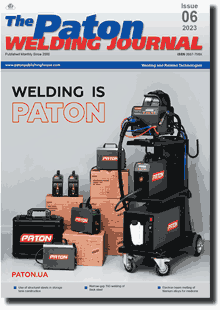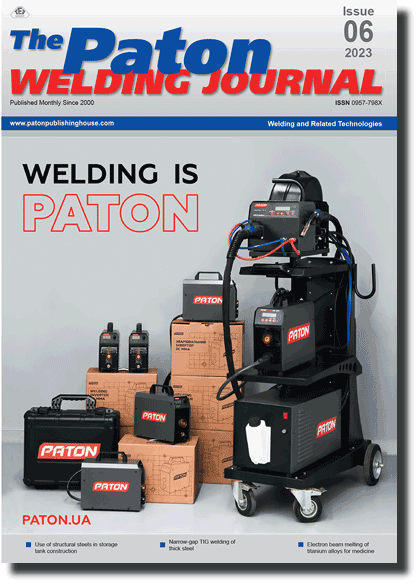| 2023 №06 (04) |
DOI of Article 10.37434/tpwj2023.06.05 |
2023 №06 (06) |

The Paton Welding Journal, 2023, #6, 32-40 pages
Mathematical modeling of residual stress relaxation during performance of postweld heat treatment
O.V. Makhnenko, O.S. Milenin, O.F. Muzhychenko, S.M. Kandala, O.M. Savytska, G.Yu. Saprykina
E.O. Paton Electric Welding Institute of the NASU. 11 Kazymyr Malevych Str., 03150, Kyiv, Ukraine. E-mail: makhnenko@paton.kiev.uaAbstract
In order to lower the level of residual stresses, welded joints of a number of structural steels are subjected to general or local postweld heat treatment by the high-temperature tempering mode. Mathematical modeling methods are widely used, alongside the experimental investigation methods, to satisfy the continuously growing requirements to welded joint quality and to optimize the welding technology. Mathematical modeling of the process of welded joint heat treatment is often performed using a simplified creep function by Norton-Bailey law at a fixed soaking temperature, but here the processes of ductile deformation taking place during slow prolonged heating and cooling, are ignored. The effectiveness of application of different models of temperature creep for mathematical modeling of the processes of relaxation of residual stresses in welded joints was studied in this work with the purpose of developing recommendations for their application for various characteristic cases of postweld heat treatment. Comparison of the results of modeling the process of stress relaxation performed on a number of examples, showed that the simplified creep function at short-term soaking during general furnace treatment can give an error compared to a more general creep model. Modeling of the local heat treatment technology revealed that the complex geometry of the component and poor choice of the heating element arrangement may lead to negative consequences, namely formation of new high residual stresses. Proper modeling of the processes of relaxation and redistribution of residual stresses in welded joints and structures as a result of general (furnace) or local post-weld heat treatment may optimize the process of furnace heat treatment and improve the quality and fatigue life of the welded structures. 16 Ref., 1 Tabl., 12 Fig.
Keywords: postweld heat treatment, high-temperature annealing, residual welding stresses, stress relaxation, mathematical modeling, creep function
Received: 10.05.2023
Accepted: 17.07.2023
References
1. Korolkov, P.M. (2006) Heat treatment of welded joints. Kyiv, Ekotekhnologiya [in Russian].2. (2007) ASME boiler & pressure vessel code VIII Div 2e an international code. New York, The American Society of Mechanical Engineers.
3. Makhnenko, V.I. (2006) Safe service life of welded joints and assemblies of modern structures. Kyiv, Naukova Dumka [in Russian].
4. (2013) Guide to methods of assessing the acceptability of flaws in metallic structures. The British Standards Institution. BS7910:2013.
5. Makhnenko, O.V., Kansala, S.M., Basystyuk, N.R., Cherkashyn, M.V. (2021) Mathematical modeling of residual stresses in WWER-1000 elements after heat treatment. The Paton Welding J., 3, 10-16. https://doi.org/10.37434/as2021.03.02
6. Stepanov, G.V., Kharchenko, V.V., Babutsky, A.I. et al. (2006) Stress-strain state of unit of collector welding-up to branch pipe of steam generator vessel during local heat treatment. Problemy Prochnosti, 6, 43-50 [in Russian].
7. Makarenko, A.A., Makhnenko, O.V. (2022) Mathematical modeling of residual stresses in composite welded joints of WWER-1000 reactor vessel cover with CSS nozzles. The Paton Welding J., 1, 33-40. https://doi.org/10.37434/tpwj2022.01.07
8. Makhnenko, O.V., Kostenevych, O.S. (2020) Impact of technological parameters of arc deposition of an anticorrosion layer in the vessel of WWER-1000 reactor on residual stress distribution. The Paton Welding J., 12, 2-14. https://doi.org/10.37434/tpwj2020.12.01
9. Rabotnov, Yu.N. (1966) Creep of structure elements. Moscow, GIFML [in Russian].
10. Iliyushin, A.A. (2004) Transactions (1946-1966). Vol. 2: Ductility. Moscow, Fizmatlit [in Russian].
11. Katanakha, N.A.,Semenov, A.S., Getsov, L.V. (2013) Unified model of long-term and short-time creep and identification of its parameters. Problemy Prochnosti, 4, 143-157 [in Russian]. https://doi.org/10.1007/s11223-013-9485-7
12. Betten, J. (2008) Creep mechanics. Berlin, Heidelberg, New York, Springer.
13. Naumenko, K., Altenbach, H. (2007) Modeling of Creep for Structural Analysis. Berlin, Heidelberg, New York, Springer. https://doi.org/10.1007/978-3-540-70839-1
14. Makhnenko, O.V., Mirzov, I.V., Porokhonko, V.B. (2016) Modeling of residual stresses, radiation swelling and stressed state of in-service WWER-1000 reactor baffle. The Paton Welding J., 4, 32-38. https://doi.org/10.15407/tpwj2016.04.03
15. Margolin, B.Z., Gulenko, A.G., Kursevich, I.P., Buchatskii, A.A. (2006) Modeling for fracture in materials under longterm static creep loading and neutron irradiation. Pt 2: Prediction of creep rupture strength for austenitic materials. Strength of Materials, 38(5), 449-457. https://doi.org/10.1007/s11223-006-0064-z
16. Hrivnak, I. (1984) Weldability of steels. Moscow, Mashinostroenie [in Russian].
Suggested Citation
O.V. Makhnenko, O.S. Milenin, O.F. Muzhychenko, S.M. Kandala, O.M. Savytska, G.Yu. Saprykina (2023) Mathematical modeling of residual stress relaxation during performance of postweld heat treatment. The Paton Welding J., 06, 32-40.The cost of subscription/purchase order journals or individual articles
| Journal/Currency | Annual Set | 1 issue printed |
1 issue |
one article |
| TPWJ/USD | 384 $ | 32 $ | 26 $ | 13 $ |
| TPWJ/EUR | 348 € | 29 € | 24 € | 12 € |
| TPWJ/UAH | 7200 UAH | 600 UAH | 600 UAH | 280 UAH |
| AS/UAH | 1800 UAH | 300 UAH | 300 UAH | 150 UAH |
| AS/USD | 192 $ | 32 $ | 26 $ | 13 $ |
| AS/EUR | 180 € | 30 € | 25 € | 12 € |
| SEM/UAH | 1200 UAH | 300 UAH | 300 UAH | 150 UAH |
| SEM/USD | 128 $ | 32 $ | 26 $ | 13 $ |
| SEM/EUR | 120 € | 30 € | 25 € | 12 € |
| TDNK/UAH | 1200 UAH | 300 UAH | 300 UAH | 150 UAH |
| TDNK/USD | 128 $ | 32 $ | 26 $ | 13 $ |
| TDNK/EUR | 120 € | 30 € | 25 € | 15 € |
AS = «Automatic Welding» - 6 issues per year;
TPWJ = «PATON WELDING JOURNAL» - 12 issues per year;
SEM = «Electrometallurgy Today» - 4 issues per year;
TDNK = «Technical Diagnostics and Non-Destructive Testing» - 4 issues per year.


